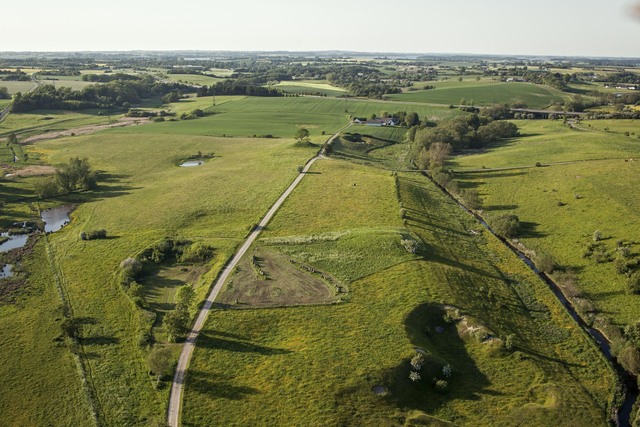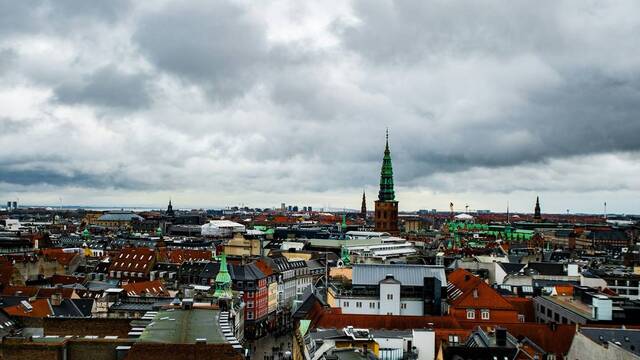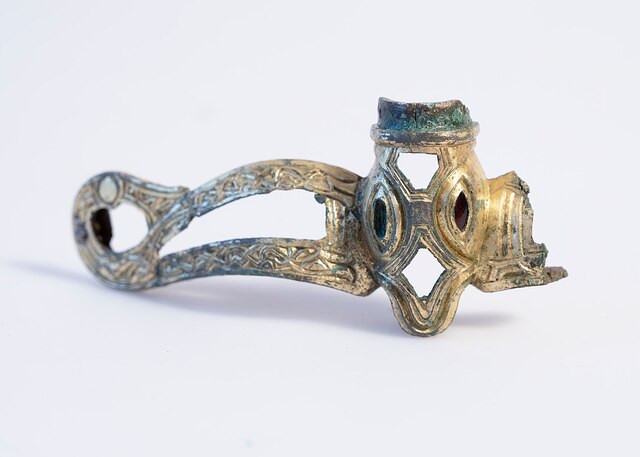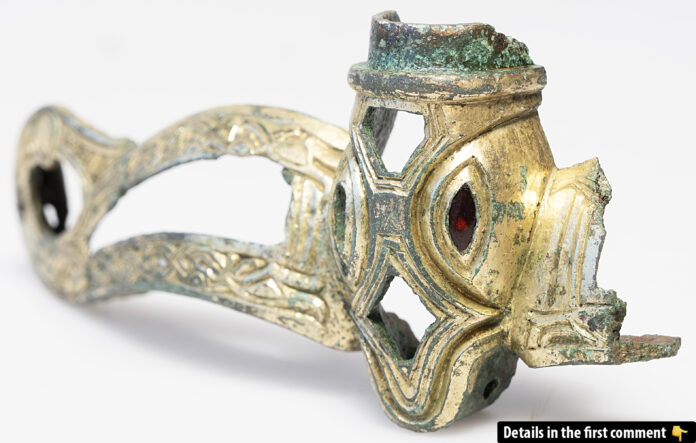In the picturesque town of Lejre, Denmark, a discovery of unparalleled historical significance has captured the attention of archaeologists and history enthusiasts alike. A fragment of a pre-Viking helmet, adorned with intricate gold plating and garnet gemstones, was unearthed in 2024, shedding light on the grandeur of Scandinavia’s Late Germanic Iron Age. This remarkable find, now displayed at the Lejre Museum, reveals a fascinating glimpse into the political, cultural, and ceremonial practices of ancient Nordic societies.
A Serendipitous Discovery
The helmet fragment was discovered in the spring of 2024 by two metal detectorists in Lejre, located on the Danish island of Zealand. Classified as danafae—a designation for historically significant artifacts with no identifiable owner—the fragment was immediately turned over to the National Museum of Denmark. Experts quickly realized the importance of the find: two adjoining pieces formed the ornate brow ridge of a helmet, crafted from bronze, gilded in gold, and adorned with deep red garnets.

The craftsmanship and design of the helmet, featuring a zoomorphic figure with pronounced teeth and large eyes, dated the artifact to between 650 and 750 A.D. This period, just before the Viking Age, is characterized by its artistic opulence and growing trade networks. While helmets from this era are rare, finding one with such intricate decoration makes this discovery one of Denmark’s most magnificent pre-Viking artifacts.
Video
Watch as an astonishing pre-Viking helmet fragment is discovered in Denmark – explore the video to uncover the historical significance of this remarkable find!
Lejre: A Center of Power and Culture
Lejre holds a unique place in Danish history. For over five centuries during the Late Iron Age and Viking Age, the town served as a royal seat and a major center of power. Although written records from the time are scarce, Icelandic sagas, Norse mythology, and poems such as Beowulf have long cited Lejre as the home of the legendary Skjöldung dynasty, the first ruling clan of Denmark.
Archaeological excavations over the last four decades have substantiated these legends. In 1986, the first remains of a royal hall were uncovered. Subsequent discoveries included a massive hall from the late 8th or early 9th century, measuring 200 feet long and 40 feet wide, believed to be the largest of its kind in Denmark. These halls, where rulers presided over their courts and received guests, highlight Lejre’s role as a center of political and religious authority.
The discovery of the helmet fragment further emphasizes Lejre’s significance. The materials and craftsmanship suggest it was a ceremonial piece, likely worn by a king or a high-ranking individual in the site’s hierarchical society. As archaeologist Julie Nielsen noted, the deep red garnets symbolize strength and power, reinforcing the artifact’s association with elite status.

A Masterpiece of Craftsmanship
What sets this helmet apart is its exceptional design and construction. Unlike similar helmets from the period, which typically feature three separate brackets for the brow ridge, the Lejre helmet’s arch is crafted from a single piece of bronze. This unique feature, described by archaeologist John Ljungkvist as unparalleled in its craftsmanship, underscores the advanced metallurgical skills of the era.
The intricate decorations on the helmet, featuring animal motifs and detailed engravings, reflect cultural and artistic influences from neighboring regions, including England and Sweden. This suggests that Lejre was not only a center of power but also a hub for cultural exchange and trade. Such connections are further supported by other findings in Lejre, including imported goods and artifacts from across Europe.

The Role of Ceremonial Helmets
Unlike battle helmets designed for protection, the Lejre helmet was clearly a ceremonial object. Its ornate design and delicate materials indicate it was meant to symbolize authority and prestige rather than to endure the rigors of combat. Helmets like this were likely worn during religious ceremonies, political gatherings, or other significant events, serving as a visual representation of the wearer’s status and power.
The discovery also aligns with Lejre’s role as a meeting place for Denmark’s political and religious elite. The town was a site where rulers, traders, and religious leaders convened to discuss matters of state, conduct rituals, and solidify alliances. The helmet’s opulence and craftsmanship underscore the importance of these gatherings and the high status of those who participated.
Implications for Scandinavian History
The helmet fragment provides valuable insights into the social and cultural dynamics of Scandinavia during the Late Germanic Iron Age. Its connections to similar artifacts in England and Sweden highlight the region’s integration into broader European trade and cultural networks. Moreover, the find adds to the growing body of evidence supporting Lejre’s status as a royal seat and a center of power.
The craftsmanship of the helmet also challenges traditional assumptions about the technological capabilities of the era. The advanced metallurgical techniques and artistic sophistication demonstrated in its construction suggest that the artisans of Lejre possessed skills on par with those behind iconic artifacts like the Sutton Hoo helmet in England.
Preservation and Public Display
Following its discovery, the helmet fragment was carefully documented by the National Museum of Denmark before being loaned to the Lejre Museum for public display. This ensures that the artifact remains accessible to scholars and the public alike, fostering a deeper appreciation for Denmark’s rich cultural heritage.
The discovery also underscores the importance of collaboration between amateur metal detectorists, professional archaeologists, and cultural institutions. By promptly turning over the artifact, the finders ensured that it could be studied and preserved for future generations, contributing to our collective understanding of history.
Conclusion
The pre-Viking helmet fragment from Lejre is more than just an artifact; it is a testament to the artistry, culture, and power of a bygone era. Its discovery adds a new chapter to the story of Lejre, illuminating the town’s role as a center of political and religious authority in Scandinavia. As one of the most magnificent pre-Viking artifacts ever found, the helmet serves as a reminder of the sophistication and interconnectedness of ancient societies.
For those who wish to witness this remarkable piece of history, the Lejre Museum offers a unique opportunity to step back in time and explore the legacy of Denmark’s early rulers. The helmet fragment not only deepens our understanding of the past but also inspires us to continue uncovering the mysteries of history, one artifact at a time.
